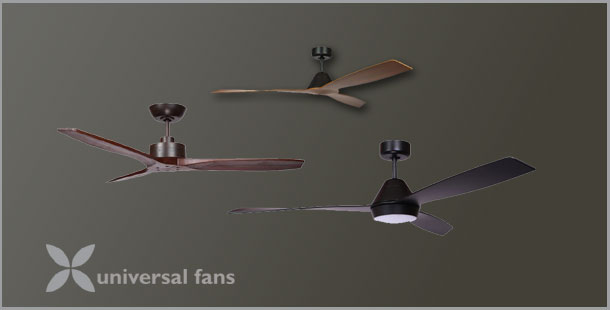
When looking at how to choose a ceiling fan, have these factors in mind: Your room dimensions, as this will affect the effectiveness of the airflow and there are fans designed specifically for smaller spaces and others specifically for larger spaces.
Second, do you need an indoor or outdoor ceiling fan? Some ceiling fans are designed for both indoor and outdoor use, but some are designed specifically for indoor or outdoor use.
Third, will the weather in your location allow you to have just any ceiling fan or you will need a wet, dry, or damp rated ceiling fan?
Fourth, do you want your fan to have a light kit? And lastly, what type of ceiling fan control will best work for you?
These are just but a few of the factors you should consider when choosing a ceiling fan.
#1 Choose A Ceiling Fan According To Your Room dimensions
I’m sure you are with me on this one. You don’t want to go picking a ceiling fan that you won’t feel its breeze because it is high and far away from you. Still, a fan that is right above your head will blow off light objects in your living room.
To choose the best ceiling fan that suits your room size, know the square footage of your room. Knowing the size of your room will help you know whether you should pick a smaller or a bigger fan.
If it turns out that the fun is too big or small for your room, you will not have enough air circulation. In short, the room size should fit the fan size.
How To Calculate The Square Footage Of A Room And Ceiling Height?
It’s pretty easy to get the square footage of your room. Find and multiply length and width measurements.
Next, you want to measure the ceiling height so that you can figure out the installation. Use the four basic guidelines of determining ceiling height to help you find the right measurement for your ceiling.
The Four Guidelines:
The four guidelines are go as follows: Flush Mount, Standard, Extended Downrod, and Sloped.
Use flush mount in a room where the ceiling height is less than 8 feet. With this application, you will be able to fix a flush that enables the blades of your fan to hang 7 feet above your floor.
For the standard application, use it on rooms that have a ceiling height of 8-10 feet. Make sure to install the fun using a downrod.
Regarding the Sloped application or otherwise known as sloping fan adaptor, use them in cases where a flat ceiling fan installation is not possible.
An extended downrod is useful when the ceiling height is more than 10 feet.
In any case, ceiling fans typically come with one or two downrods that have different measurements. An extended downrod is useful when the downrods provided aren’t long enough for the required length. A 6″ inch downrod is ideal for use on a 9-foot ceiling.
For every additional height of ceiling add a 6″ inch downrod. What this means is that if your ceiling height gets to 10 feet your downrod should be at 12″.
#2 Determine The Location Of Your Fan
Knowing where you’re going to place your fan is important as it will help you choose a ceiling fan according to your primary needs.
Here’s why this is important, there are two categories of fans: the outdoor ceiling fan and the indoor ceiling fan. Indoor fans are not designed for the outdoor.
A slight amount of moisture present on the indoor fan will interfere with its functionality. When moisture gets into contact with the motor, the fixture won’t last long.
Understand that using the outdoor and indoor fan interchangeably could have irreparable effects on your new-found ceiling fan.
And here are possible effects you want to avoid facing:
Rusting: It is bound to occur where the surface of your ceiling fan begins to fade or tarnish.
Burnings: When rusting occurs on the hardware, it leads to openings that expose the electrical wires that end up burning the ceilings and the fan itself.
Melting: Blades warp or melt in the presence of heat or moisture leading to wobbles and poor air circulation.
#3 How To Choose A Ceiling Fan According To UL Rating
Now, this is important when learning how to choose a ceiling fan. Most ceiling fans come with the manufactures disclaimer that indicates where you should best use the ceiling fan.
Referred to as the (UL) or the Underwriter Laboratories rating, it will guide you as a buyer to purchase a ceiling fan according to its convenient location.
The (UL) helps you find a good ceiling fan for summer convenient to suit your cooling needs. For instance, unlike indoor fans, manufacturers design the outdoor fan to withstand the harsh environmental conditions in the outdoor environment.
According to UL, there are dry-rated, wet-rated, and damp-rated ceiling fans. You may get a little bit mixed up here but this is the catch:
Dry-rated Ceiling Fans
Ceiling fan for summer needed for the indoors fall under this category. These kinds of summer ceiling fans are good for using indoors and shouldn’t be exposed to moisture.
You should also avoid using them in damp locations. The best locations you can use for the dry-rated ceiling fans are the living room, bedroom, dining room, or the finished basement.
Damp-rated Ceiling Fans
Damp-rated fans function best in the outdoor environment. However, beware of exposure to snow, or direct rain. You don’t want to shorten its durability.
The best part is that it can withstand moisture and damp areas. The best location for ceiling fans in the damp-rating category is the kitchen, bathroom, covered patio, and the carport.
Wet-rated Ceiling Fans
The odds are getting better here. The wet-rated are designed for major harsh conditions. You will notice that they can withstand ocean salty breezes, and can also handle snow and intense rain.
So, if you are up to beating the summer heat in the outdoor, the wet rated ceiling fans are the best you can use.
#4 Check The Control Options
Your ceiling fan for summer options may present you with some control choices that you will need to choose from. Apart from knowing how to choose a ceiling fan, how do you know which is the right control option for you?
Let me walk you through the different options at your disposal. You could use a remote, a wall switch, or a pull chain. It all boils down to your personal preference.
In most cases, the mode of operation will depend on the fan you choose. It’s easier to switch on and off a ceiling fan with remote control from the comfort of your sheets or couch.
The wall control is another good choice you could opt for but not the most convenient. It allows you to operate the fan speed, it’s lighting, and direction by simply pressing a button.
On the flip side, this option is good for you if you have kids around.
The wall button usually comes with a range of up to 40 feet. The wall control can function best in other rooms, such as the kitchen, the living room, and the dining.
How about the pull chain? It works best with low-profile ceiling fans. It’s also ideal for use in places with low traffic such as the guest house.
#5 Decide Whether You Want The Fan To Also Light Up Your Room

When choosing a ceiling fan for summer, you will also have to decide on whether you want your ceiling fan to come with a lighting kit.
Luckily for you, most ceiling fans come with a lighting kit. Nevertheless, your preference is what matters most since you can also order ceiling fans without light.
If you are in a room that is well lit with good natural lighting, you don’t need to bother with ordering a fan with light.
However, if you feel additional lighting is necessary for your room space, then order one by all means.
But wait, there is one more thing that you will need to decide upon. What is your preferred lighting source? Is it halogen, LED, or fluorescent?
LED source of light come with energy-efficient bulbs that consume little energy. Their average lifespan is 50,000 hours.
The halogen lifespan has an average lifespan of 1,500 hours and is ideal for use with easy to reach fans.
The average lifespan of the fluorescent is 10,000 hours. The fluorescent bulb also uses less percent energy compared to incandescent sources.
#6 Check Ceiling Fan Airflow And Efficiency
The airflow that a ceiling fan emits for the summer is measured in CFM. Airflow is the amount of air that a fan delivers.
How do you calculate CFM so that you know the amount of air your ceiling fan for summer emits?
Do the calculations when the fan is at a high speed. Take the speed number and multiply it by the number of watts used. A higher CFM is an indicator of an efficient ceiling fan.
Averagely, you need 1 CFM per square foot of your floor area. However, most ceiling fans come with a CFM label, so you don’t have to bother about the calculations.
Final Words
Ceiling fans come in handy when you need that cool breeze. They are also cheaper to run than air conditioners, and they add to the general aesthetic of your room.
Check out an article we´ve written about the best outdoor ceiling fan where we have included comprehensive reviews on various ceiling fans, so you can check it to see our recommendations.
We hope that with the above guide on how to choose a ceiling fan you are in a better position to narrow down to one and enjoy years of a smooth air circulation.
Any ceiling fans in mind? Let us know your thoughts!







